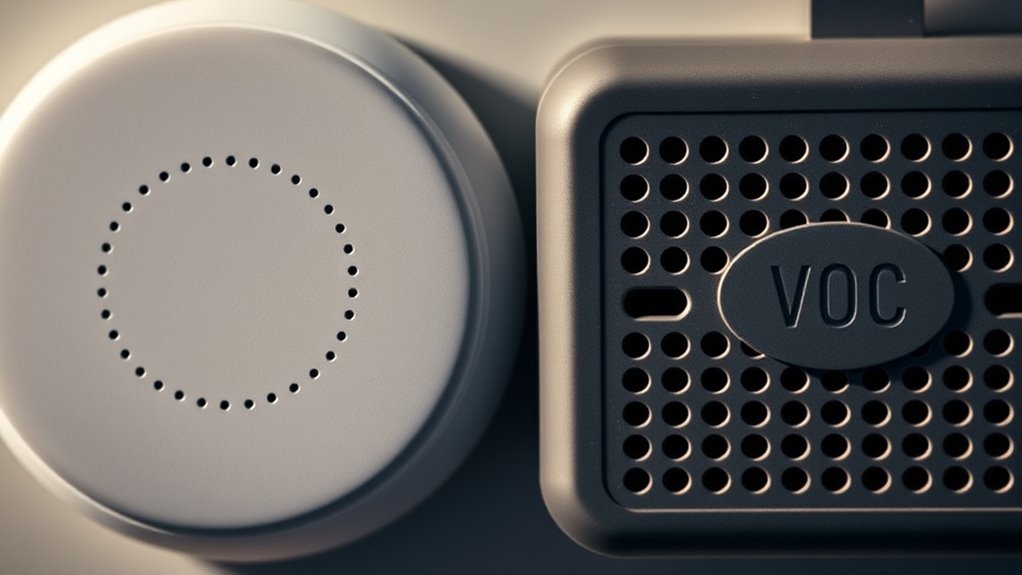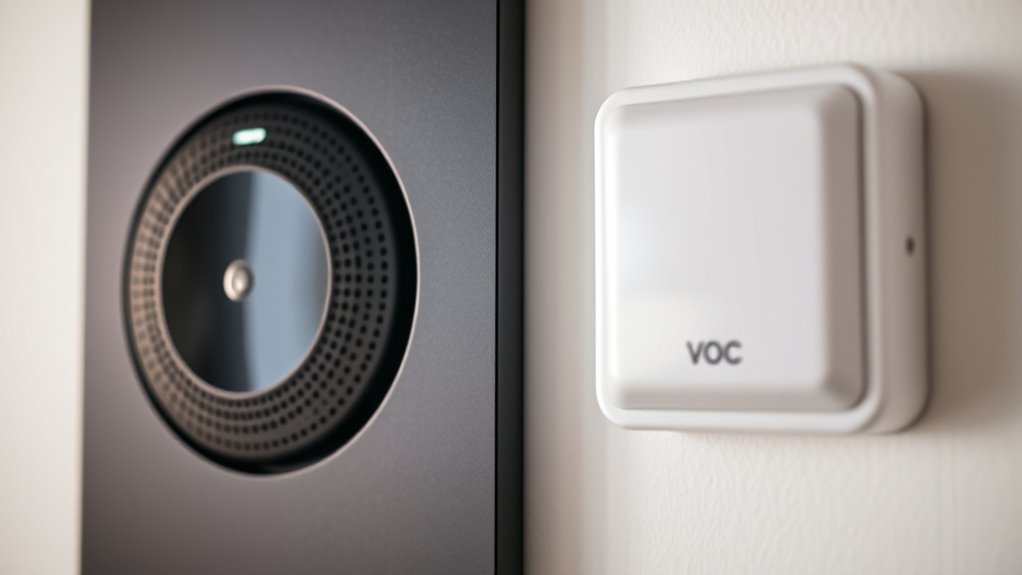Choosing between smoke and VOC sensors depends on what you want to monitor. Smoke sensors detect particles from fires, providing quick alerts for fire safety. VOC sensors track organic compounds from paints, cleaning supplies, or furnishings, helping improve indoor air quality. For extensive protection, combining both types offers better safety and health benefits. If you want to learn more about selecting the best sensor for your needs, keep exploring the differences and applications.
Key Takeaways
- Smoke sensors detect combustion particles for fire safety, while VOC sensors identify a broad range of organic chemical emissions.
- Use smoke sensors primarily for fire detection; VOC sensors monitor chemical pollutants affecting indoor air quality.
- Proper calibration ensures accurate detection and reduces false alarms for both sensor types.
- Combining both sensors provides comprehensive indoor air quality and safety monitoring.
- Choose based on your specific needs: fire prevention, chemical exposure, or overall indoor air health.

Have you ever wondered how smoke and VOC sensors differ in protecting your indoor air quality? Understanding these differences is essential to choosing the right monitor for your home or workplace. Smoke sensors are designed to detect particles from combustion processes, alerting you to potential fires or smoke hazards. VOC sensors, on the other hand, focus on volatile organic compounds, which are emitted by products like paints, cleaning supplies, or furnishings. Both types of sensors play critical roles, but they serve different purposes based on the pollutants they target.
When evaluating which sensor to install, you need to take into account air quality standards that are relevant to your environment. These standards set acceptable levels for various pollutants, helping you determine whether your indoor air is safe. Smoke sensors are often calibrated to respond quickly to particles that resemble smoke, while VOC sensors need to detect a broad range of organic compounds at low concentrations. Proper sensor calibration is indispensable for accuracy; if sensors aren’t calibrated correctly, they may give false alarms or fail to alert you when needed. Regular calibration ensures that the sensors’ readings align with official air quality standards, maintaining their reliability over time.
In residential settings, a smoke sensor is usually a must-have for fire safety, but adding a VOC sensor can help improve overall air quality by alerting you to chemical emissions that might cause headaches, dizziness, or longer-term health issues. For commercial or industrial environments, both sensors are often necessary, especially in areas where combustion or chemical processes occur regularly. Properly calibrated sensors can distinguish between normal background levels and dangerous spikes, giving you peace of mind and actionable information. Additionally, integrating these sensors with air quality management systems can optimize indoor safety and comfort.
Frequently Asked Questions
How Often Should I Calibrate Smoke and VOC Sensors?
You should calibrate your sensors regularly to maintain sensor accuracy. For smoke sensors, calibration every six months is recommended, but check your manufacturer’s guidelines. VOC sensors may need calibration every three to six months, depending on usage. Regular calibration ensures reliable readings and peak performance. Keep track of calibration dates and perform it more frequently if you notice inconsistent or false alarms, ensuring your monitors remain dependable.
Can Smoke Sensors Detect Other Airborne Pollutants?
You might wonder if smoke sensors can detect other airborne pollutants. While they excel at identifying smoke particles, they typically don’t detect gases like VOCs or other pollutants. For better air quality improvement, consider installing multi-sensor systems that combine smoke and VOC detection. Follow sensor installation tips carefully—place them in key areas, avoid drafts, and make sure proper calibration—to maximize their effectiveness and protect your indoor environment.
Are VOC Sensors Effective Against All Types of VOCS?
Imagine a key that opens many doors but doesn’t fit every lock—that’s like a VOC sensor. While VOC sensors are versatile, they have limitations and might not detect all types of VOCs effectively. You need to understand these VOC sensor limitations to guarantee proper coverage. Smoke sensors, on the other hand, are designed specifically for particles, so they excel at detection but lack the versatility of VOC sensors.
What Is the Typical Lifespan of These Sensors?
The typical lifespan of VOC sensors usually ranges from 2 to 5 years, depending on sensor durability and usage conditions. You should consider lifespan considerations when choosing a monitor because sensor performance can decline over time. Regular calibration and maintenance help extend their effectiveness. Be sure to check the manufacturer’s guidelines for specific sensor durability details, as environmental factors and sensor quality influence overall lifespan.
Do Sensors Require Regular Maintenance or Replacement?
Considering the gentle art of sensor calibration, you’ll find that regular maintenance helps maximize sensor durability. While these sensors are built to last, dust, environmental factors, and usage patterns can influence their performance. Periodic checks and calibration ensure accurate readings, preventing unnecessary replacements. By caring for your sensors, you extend their lifespan, keep your environment safe, and enjoy peace of mind, knowing they’re functioning effectively whenever you need them.
Conclusion
Choosing between smoke and VOC sensors isn’t just about detection; it’s about understanding what you value most—safety or air quality. While smoke sensors instantly alert you to fires, VOC sensors help you breathe cleaner air daily. Both protect your space, but knowing their differences helps you make smarter decisions. Whether you prioritize immediate danger or long-term wellness, selecting the right sensor adds a layer of security you can’t afford to overlook.









